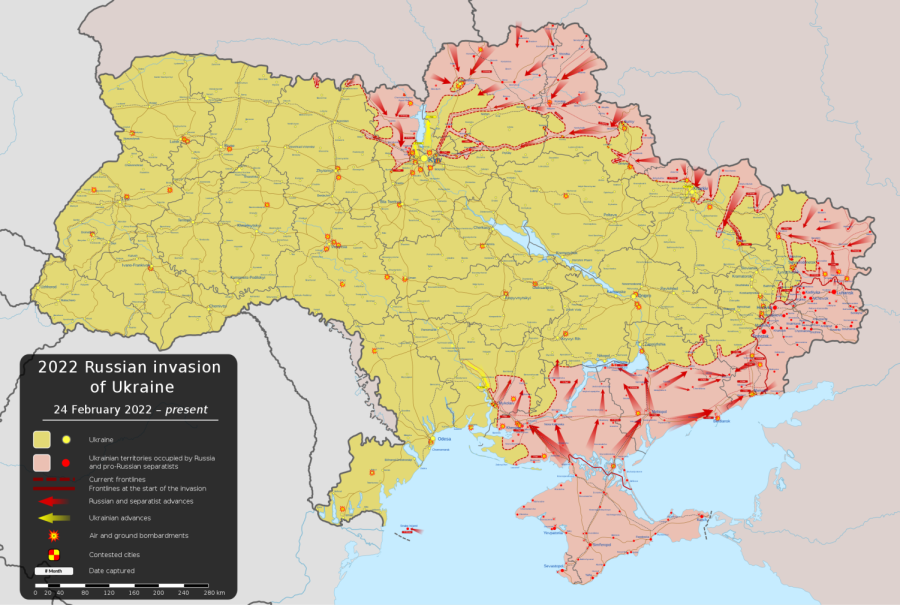Evaluating the Western Response to Russia’s Invasion of Ukraine
A map showing the current front lines in the Russian invasion of Ukraine, accurate as of 3/19/2022. Russian troops are sieging down Mariupol, Cherhiniv and Sumy, advancing in a broad front in Ukraine’s south and east. Kyiv and Kharkiv are holding out, despite heavy shelling and airstrikes. Source: https://commons.wikimedia.org/wiki/File:2022_Russian_invasion_of_Ukraine.svg
On February 24, Russian President Vladimir Putin declared a “Special Operation” to “pacify” and “denazify” Ukraine, which he accused of committing genocide against Russian people. Shortly after that declaration, Russian tanks rolled across the border, and a bloody new war commenced. But while the fighting was restricted to Ukraine, the effects of the conflict reverberated worldwide in its security, economic, and diplomatic implications. This left the U.S and its allies with a tough question to answer: Should they intervene, and if so, how?
The first question, whether the west should intervene in some way, is easy to answer. Ukraine is a western-aligned democracy being invaded by an autocratic state; the “free world,” if it intends to defend its values and protect a friendly nation, must support Ukraine. Further, regardless of ideology, Russia must be shown that invading another nation is unacceptable in today’s world. The “Rules-Based Order” set up after World War II, which has successfully kept conflict limited* and pushed countries to resolve their disputes through diplomacy, may not survive if the west simply accepts Russia’s invasion of another sovereign nation on the flimsiest of pretexts. Its collapse could mark a resurgence of war worldwide, potentially resulting in millions of needless deaths. The stakes are high, and the U.S and its European and Asian allies must act. But how?
First and foremost, it is clear that the U.S or NATO should not get involved in a direct war with Russia. Russia has thousands of operational nuclear missiles, and in a losing situation, there is no guarantee that Putin wouldn’t use some in “tactical” strikes on western armies or military installations. Even if that doesn’t happen, during an active military conflict, it is incredibly difficult for opposing sides to effectively communicate; any miscalculation could also rapidly escalate into nuclear war. But let’s say it doesn’t go that far. A conventional war against Russia would still be incredibly bloody and difficult to win. While the Russian army is not as technologically advanced as western ones, it is numerically massive, and Putin would undoubtedly call in reservists and possibly even enforce conscription to overwhelm his enemy. To fight this, the U.S and allies would need to commit significant forces, leading to immense economic strain and substantial loss of life. Such a major war would also have a destabilizing influence on the rest of the world, with other nations possibly starting their own wars while the U.S, Europe, and Russia are distracted.
Getting into a war with Russia does not only mean putting troops on the ground in Ukraine. It includes any action that results in Russian and U.S/NATO forces exchanging fire with each other. Such a gimmick as a “no-fly zone,” something that has repeatedly been suggested by Ukrainian President Zelenskiy as a way to end Russia’s aerial bombing campaign, would fall into this category. Simply declaring “planes cannot fly over Ukraine” will have no effect unless such an edict is enforced; enforcement will require offending planes (including Russian ones) to be shot down, which is tantamount to a declaration of war.
So far, the U.S and its allies are refusing to directly engage Russian forces in any way, and are hesitant to do anything that may even be interpreted as belligerence against Russia. Make no mistake: this is a very good move. No matter what comes out of this situation, the worst possible outcome is full blown war between the U.S and Russia, the two most militarily powerful nations in the world.
In lieu of war, the U.S can find ways to pressure Russia. Sanctions on Russian goods, the confiscation of foreign exchange reserves, and the shutting down of airspace to Russian airlines are just some of the actions America and its allies have taken in the last two weeks to cripple the Russian economy (full list of sanctions). While sanctions have a reputation for not working too well, this set of sanctions on Russia is one of the largest, most comprehensive packages ever passed against such a large economy. There is evidence that it is having a genuine impact – the ruble (Russian currency) has collapsed, the Moscow Stock Exchange has been shut down, and foreign debt defaults are imminent. Wars are expensive; by targeting Russia’s economy, the west is targeting Putin’s ability to fight a sustained conflict. At the same time, the west is also supplying Ukraine with advanced weapons including shoulder mounted anti-tank missiles, surface-to-air missiles, and drones. This makes it necessary for Putin to fight a long and sustained war to defeat Ukraine, because Ukraine is being provided with the tools to contest every inch of the Russian advance. The goal of this is to force Russia to the negotiating table. With a peace treaty, Russia may still take some land, but Ukraine will be able to hold onto its sovereignty and its democracy – which is the ultimate goal.
So far, the U.S has done nearly everything right in regards to this conflict by avoiding direct war with Russia and materially supporting Ukraine. All that needs to be done now is to maintain the pressure, and keep the aid to Ukraine flowing. If Russia is bled white like it was in the Winter War**, it will be forced to make peace for its own sake. Those advocating for a more belligerent policy must be ignored – a reckless escalation of the war has to be avoided at all costs.
*Yes, I am aware that wars and human rights violations have happened after World War II, and the U.S was sometimes (hypocritically) the one at fault. That does not negate the fact that the U.S and allies helped set up the net of international alliances and organizations that has played a key role in the reduction of conflict over the last 80 years.
**In 1939, the Soviet Union invaded Finland, expecting to overrun it in weeks. Instead, they got bogged down for more than three months in a brutal war against defenders who used the climate and terrain to their advantage. The Finns inflicted about 350,000 casualties on the Soviet army, putting up such fierce resistance that the Soviets took a negotiated peace instead of demanding total surrender. Finland lost, but they retained their independence. See https://en.wikipedia.org/wiki/Winter_War.







